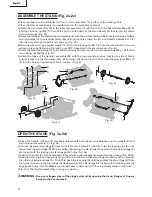
5
• READ INSTRUCTION MANUAL AND KNOW YOUR TOOL.
Read and familiarize yourself with
entire instruction manual. Learning the tool’s proper applications. Limitations, and specific potential hazards
will greatly minimize the possiblity of accidents and injury. Make sure all users are familiar with its warnings
and instructions before using tool.
• GUARD AGAINST ELECTRICAL SHOCK BY PREVENTING BODY CONTACT WITH
GROUNDED SURFACES.
For example, pipes, radiators, ranges, refrigerator enclosures.
• KEEP GUARDS IN PLACE
and in good working order. Blade guard must be in place for all through
cut operations. Reinstall the blade guard immediately after finishing any non-through cut operations which
require removal of the blade guard. Never operate the saw without the blade guard in place for any cut
which does not require it to be removed. Make sure the blade guard is operating properly before each
use. A guard that is loose, damaged, or is not functioning correctly must be repaired or replaced.
• MAKE SURE THE SAW BLADE IS NOT CONTACTING THE GUARD, RIVING KNIFE OR
THE WORKPIECE BEFORE THE SWITCH IS TURNED ON.
Inadvertent contact of these items
with the saw blade could cause a hazardous condition
• REMOVE ADJUSTING KEYS AND WRENCHES.
Form habit of checking to see that keys
and adjusting wrenches are removed from tool before turning it on.
• KEEP WORK AREA CLEAN.
Cluttered areas and benches invite accidents.
DO NOT
leave tools or
pieces of wood on the saw while it is in operation. Distraction or a potential jam can be dangerous.
• DO NOT USE IN DANGEROUS ENVIRONMENTS.
Do not use power tools in damp or wet locations
or expose to rain. Keep the work area well lit. Locate the tool in a level area. It should be installed in an
area that provides enough room to easily handle the size of your workpiece. Cramped, dark areas, and
uneven slippery floors invite accidents.
• KEEP CHILDREN AND VISITORS AWAY.
All visitors should wear safety glasses and be kept a safe
distance from work area. Do not let visitors contact tool or extension cord while operating.
• MAKE WORKSHOP CHILDPROOF
with padlocks and master switches, or by removing starter keys.
• DON’T FORCE TOOL.
It will do the job better and safer at the feed rate for which it was designed.
• FEED WORKPIECE AT AN EVEN PACE. DO NOT BEND OR TWIST THE WORKPIECE. IF
JAMMING OCCURS, TURN THE TOOL OFF
IMMEDIATELY, UNPLUG THE TOOL THEN
CLEAR THE JAM.
Jamming the saw blade by the workpiece can cause kickback or stall the motor.
• USE RIGHT TOOL.
Don’t force the tool or attachment to do a job it was not designed for. Don’t use it
for a purpose not intended.
• USE THE PROPER EXTENSION CORD.
Make sure your extension cord is in good condition. Use
only a cord heavy enough to carry the current your product will draw. An undersized cord will cause a
drop in line voltage resulting in loss of power and overheating. A wire gauge size (A.W.G.) of at least 14
is recommended for an extension cord 25 feet or less in length. If in doubt, use the next heavier gauge.
The smaller the gauge number, the heavier the cord.
• DRESS PROPERLY.
Do not wear loose clothing, gloves, neckties, or jewelry. They can get caught and
draw you into moving parts. Rubber gloves and nonskid footwear are recommended when working
outdoors. Also wear protective hair covering to contain long hair.
• ALWAYS
wear safety goggles that comply with United States ANSI Z87.1 and a face shield or dust mask
if operation is dusty. Everyday eyeglasses have only impactresistant lenses, they are
NOT
safety glasses.
• SECURE WORK.
Use a clamps or vice to hold workpiece when practical. It’s safer than using your hand
and frees both hands to operate tool.
• DON’T OVERREACH.
Keep proper footing and balance at all times.
• MAINTAIN TOOLS WITH CARE.
Keep tools sharp and clean for better and safer performance. Follow
instructions for lubricating and changing accessories.
• DISCONNECT TOOLS.
All tools should be disconnected when not in use, before servicing, or when
changing attachments, blades, bits, cutters, etc. Turn the machine “OFF” before disconnecting tools to
avoid an accidental start when plugging the tools in again.The accidental start may cause serious injury.
Do not touch the terminal or plug’s metal part when inserting or removing the plug from an outlet.
• DO NOT PLUG IN OR PULL OUT FROM POWER SUPPLY WITH WET HANDS TO PREVENT
ELECTRIC SHOCK.
• USE RECOMMENDED ACCESSORIES.
Consult the operator’s manual for recommended accessories.
GENERAL SAFETY RULES
English






































